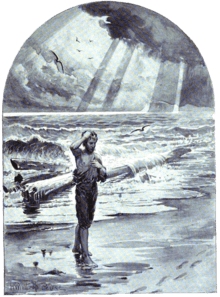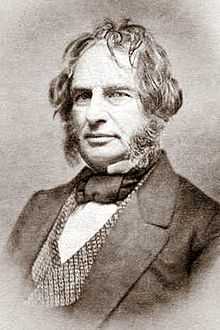A Psalm of Life

Tell me not, in mournful numbers,
Life is but an empty dream!—
For the soul is dead that slumbers,
And things are not what they seem.
Life is real! Life is earnest!
And the grave is not its goal;
Dust thou art, to dust returnest,
Was not spoken of the soul.
Not enjoyment, and not sorrow,
Is our destined end or way;
But to act, that each to-morrow
Find us farther than to-day.
Art is long, and Time is fleeting,
And our hearts, though stout and brave,
Still, like muffled drums, are beating
Funeral marches to the grave.
In the world's broad field of battle,
In the bivouac of Life,
Be not like dumb, driven cattle!
Be a hero in the strife!
Trust no Future, howe'er pleasant!
Let the dead Past bury its dead!
Act,—act in the living Present!
Heart within, and God o'erhead!
Lives of great men all remind us
We can make our lives sublime,
And, departing, leave behind us
Footprints on the sands of time;
Footprints, that perhaps another,
Sailing o'er life's solemn main,
A forlorn and shipwrecked brother,
Seeing, shall take heart again.
Let us, then, be up and doing,
With a heart for any fate;
Still achieving, still pursuing,
Learn to labor and to wait.
.
"A Psalm of Life" is a poem written by American writer Henry Wadsworth Longfellow.
Background
The poem expresses the ideology that life is a solemn virtue and one should make it worthwhile by becoming a role-model generations. The poem also stresses that as long as one lives, one should strive for making his life note-worthy, and inspire others to create their own 'footprints'.
Composition and publication history
Longfellow wrote the poem shortly after completing lectures on German writer Johann Wolfgang von Goethe and was heavily inspired by him. He was also inspired to write it by a heartfelt conversation he had with friend and fellow professor at Harvard University Cornelius Conway Felton; the two had spent an evening "talking of matters, which lie near one's soul:–and how to bear one's self doughtily in Life's battle: and make the best of things".[1] The next day, he wrote "A Psalm of Life".
The poem was first published in The Knickerbocker attributed only to "L." Longfellow was promised five dollars for its publication, though he never received payment.[2] "A Psalm of Life" and other early poems by Longfellow, including "The Village Blacksmith" and "The Wreck of the Hesperus", were collected and published as Voices of the Night in 1839.[3] This volume sold for 75 cents.[4]
In the summer of 1838, Longfellow wrote "The Light of Stars", a poem which he called "A Second Psalm of Life".[5]
References
- ↑ Thompson, Lawrance. Young Longfellow (1807–1843). New York: The Macmillan Company,1938: 267.
- ↑ Cody, Sherwin. Four American Poets: William Cullen Bryant, Henry Wadsworth Longfellow, John Greenleaf Whittier, Oliver Wendell Holmes; a Book for Young Americans. New York: Werner School Book Company, 1899: 106–107. Accessed August 12, 2008
- ↑ Calhoun, Charles C. Longfellow: A Rediscovered Life. Boston: Beacon Press, 2004: 137–139. ISBN 0-8070-7026-2.
- ↑ Irmscher, Christoph. Longfellow Redux. Chicago: University of Illinois Press, 2006: 54. ISBN 978-0-252-07586-5
- ↑ Thompson, Lawrance. Young Longfellow (1807–1843). New York: The Macmillan Company,1938: 270.
External links
| Wikisource has original text related to this article: |
| |||||||||||||||||
